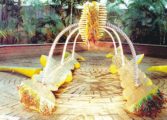Shashikala Srinivasan |
While there has been a long-standing narrative of crisis on the institution of the university in India and the West, we can identify some conspicuous differences in the way the crisis is formulated and addressed in the two different contexts. An articulation of the crisis in the Western university is accompanied by reflections on the institution of the university and the specific conception of education it embodies. The term liberal (arts) education is often used to capture this specific ideal of education, functioning to differentiate the key institution of modern higher learning, the university, from technical, specialist, professional institutions on the one hand and confessional, religious institutions on the other. An extensive body of writing on the idea of the university and liberal education, a flourishing genre of philosophical writing that emphasizes the centrality of humanities and the importance of cultural inheritance to the formation of the student, has developed over two centuries in the West. This is in striking contrast to the debate on the crisis in the university in non-Western countries like India where this reflective genre is almost absent. Instead, the problem in India is often formulated in bureaucratic and social terms with an emphasis on structural, financial and administrative aspects as well as on issues of social justice. Hence, managerial and systemic problems, the divisive nature of the social fabric, the “irrational” traditions of the land, problems of infrastructure and funding etc…, get highlighted in the literature. Much of this literature on the crisis does not talk about the notion of education or formation at all.
Secondly, the crisis in the university in the West is often articulated in terms of the decline of liberal education or in terms of a loss of the concept of education. The presumption is that there exists something worthy of being preserved, which now faces disintegration. In India, however, the crisis is expressed in terms of liberal education and its notion of knowledge, learning and selfhood not taking root, of the “inadequacy of a borrowed structure,” in terms of a “lack,” incompleteness or a “failure” on the part of Indians to acquire certain critical normative goals or articulated in terms of alien-ness of modern institutions and concepts. Liberal education in our context, on the rare occasions that it is used, has often remained a vague, empty term, without any substantive and intellectual content.
The differing narratives of crisis and the formulation of the problem across the Western and Indian contexts make it clear that the crisis is experienced differently in the two different contexts. For analytical purposes, it is necessary to separate the two strands in order to contextualize the experience of the crisis and gain a firmer grasp over what is at stake in these debates.
How have scholars diagnosed the crisis in the university in the West? For most scholars, the crisis is a reflection of a crisis in the ideal of liberal education that underlies the institution. It is recognition of the obstacles that come in the way of the formation of the student, in the further refinement of knowledge traditions, that are seen as essential for the continuity of a culture and the formation of its people. We can find two dominant strands in the way the problem is diagnosed: a) The traditional ideal of liberal education underlying the modern idea of the university as envisaged in the classical and Enlightenment tradition is under threat from various kinds of forces. We need to recover and reassert the original purpose of the university[1] b) The traditional ideal of liberal education is inadequate to address the needs of a democracy, by restricting the idea of a good life to an elite. We need to rethink the idea of liberal education to make it suitable for democratic citizenship.[2] I shall discuss Allan Bloom, as the representative of the first strand, and Martha Nussbaum, as representing the second strand. I have chosen books by these two authors out of a spate of publications on the issue in the last three decades, because they provide us with good entry points into two contrarian views on liberal education, with Bloom representing the conservatives and Nussbaum, the liberals. How do they flesh out the concept of liberal education and what role do they attribute to culture in it?
In his provocative book Closing of the American Mind: how Higher Education has Failed Democracy and Impoverished the Souls of Today’s Students (1987) Allan Bloom, the American classicist, tapped into the larger anxiety about the state of the university and other aspects of twentieth century American intellectual life. The eccentric, yet sometimes profound book, that broke into the New York Times non-fiction bestseller list, went on to become an astounding commercial success. The book was published during the heydays of multiculturalism and the extraordinary hostility that it produced among liberal and other scholars prevented a more balanced assessment of the book. Almost thirty years later, it might be worthwhile to revisit some of the central concerns Bloom raises. How did Bloom diagnose the crisis in the university and what cure did he propose?
Bloom locates the cause for the crisis in the university and the ideal of liberal education to the presence of rampant relativism in American campuses and in the larger American society. Often expressed in the statement that truth is relative, relativism generated a milieu where all opinions and conceptions of good life are regarded as equally valid, none right or wrong. Since values are a personal matter, not to be subject to critical scrutiny or debate, it follows that one cannot criticize another culture by laying claim to an objective, neutral viewpoint. Instead, what we have is an uncritical celebration of “openness” and “tolerance” on American campuses, which, according to Bloom, is really the “closing of the mind” because it is a refusal to engage seriously with ideas other than your own, and prevents any reasoning on conceptions of good life in order to evaluate them. This, for Bloom, is the forsaking of the genuine openness and the rejection of the Socratic idea of the university founded on the search for a good life through reason.
What has made relativism so predominant in campuses and American life? Bloom traces the pervasiveness of relativism to the unacknowledged German connection of the nineteenth century high intellectual tradition and the peculiar ways in which German philosophical vocabulary (particularly that of Nietzsche, Freud and Weber) of “self”, “inner-directedness,” “culture” and “values” got democratized and penetrated into American social life. With secularization and the pronouncement of the death of God by German high intellectual tradition, “good” and “evil” gave way to “values,” indicating “radical subjectivity of all belief about good and evil.[3]” A new intellectual stance emerges where one is no longer admired for being able to subject various notions of good life to scrutiny by reasoning about them, but is admired for one’s commitment to value per se, not its content (or its rightness or wrongness) but how one holds it. The notion of autonomy becomes merely one of holding onto one’s own value intensely, understood largely as an expression of subjective preference, which cannot be criticised. One no longer “discovers good life” through critical reasoning but one “invents values” and this revolution has necessitated a whole new vocabulary of “self”, “commitment” and “identity” where one finds oneself by delving into the depths of one’s subjectivity. The Socratic call to “know thyself” which meant an invitation to philosophy to figure out place of man within the order of things, has got transformed into “be yourself,” thereby making sincerity and authenticity the main criteria of a “healthy self,” a new political justification replacing reason. What began as science, in other words, for Bloom, has given way to psychology and psychoanalysis.






Leave a Reply
You must be logged in to post a comment.